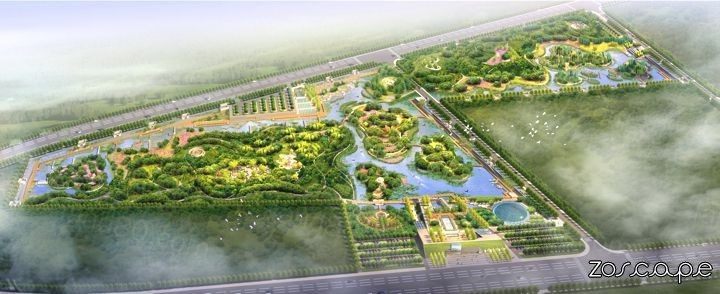General Planning of ShangQiu Botanical Park
植物园总体规划

唐宋文化

Shangqiu Botanical Garden design highlights two aspects of the characteristics:
The first is the shaping of land and water space, reproducing Shangqiu natural geographical landscape changes and the ancients feature based on the natural environment and create ways; Shangqiu names that here was originally undulating hills. Historical records, thousands of years ago Shangqiu plains than ten meters or tens of meters lower now, there are numerous mounds on the plains, hills and lakes. Since the Southern Song Dynasty (1127 - 1279), after the early years of the Yellow River flows through Shangqiu, making it the natural landscape has changed dramatically: the Yellow River dike breach, diversions, silt shallow natural river, filling the original lake, annihilation of Confucius Gang, also raise the ground, forming Shangqiu Yimapingchuan geographical features. The ancients in order to avoid the Yellow River flood, building made of many high-profile, a local cultural landscape of the typical portrayal. Shangqiu most famous attractions and Taiwan related, such as the park site adjacent to China's first astronomical observation - Vulcan Taiwan, as well as sunflower mound Alliance Taiwan to commemorate Confucius elegant table, a picturesque three hills station, as well as a symbol of love green hills station and so on.
Secondly, in terms of plant culture to create, reflect different times people understand the different ways plants, as well as local people loved plant landscape types. The whole garden is divided into three major scenic spots from north to south, showing the history of the most representative of Shangqiu ancient culture, Tang and Song dynasties and modern cultures. Ancient cultural attractions to Shen Nong tasted a hundred herbs as the main line, the performance of the ancient people on the identification and classification of the initial plant knowledge, such as edible, poisonous, medicinal, etc.; Song Shangqiu famous cultural attractions papaya garden, and other ancient monuments liangyuan Monarch and the "acacia", "peach Blossom Fan" and other historical allusions as a prototype to show the historical development of Shangqiu plants bloom culture; modern cultural attractions to scientific plant classification system as the main line, showing the modern methods of plant identification and classification scientific understanding.
植物园效果图

一、项目概况: 商丘植物园园址位于商丘古宋城西南方向,现状是一片农田,地势平坦,景色单一。园址周边滨临多条城市道路,并被一条次干道一分为二,成为南北两个倒梯形的片区。场地南北方向较长,约1304米,东西方向相对狭窄,南端最窄处仅有132米。浅层地下水水位枯水期约为-5.5米,丰水期约为-5.2米。 二、方案特色
商丘植物园设计突出了两个方面的特点:
首先是水土空间的塑造,再现了商丘自然地理景观的变迁和古人基于自然环境特征的营造方式;商丘的地名表明,这里原本是起伏的丘陵地带。史料记载,数千年前的商丘平原较现在低十几米或几十米,平原上有众多的丘、冈和湖泊。自南宋(1127年~1279年)初年黄河改道流经商丘后,使这里的自然地貌发生了巨变:黄河的决溢、改道,淤浅了天然河道,填平了原来的湖泊,湮没了丘冈,也抬高了平地,形成商丘一马平川的地理风貌。古人为了躲避黄河泛滥,筑造了许多高台,成为当地人文景观的典型写照。商丘著名的景点大多与台有关,如与园址相邻的中国最早的观星台——火神台,还有葵丘会盟台,纪念孔子的文雅台,风景如画的三陵台,以及象征爱情的青陵台等。
其次,在植物文化的营造方面,反映了不同时代人们认知植物的不同方式,以及当地人们喜闻乐见的植物景观类型。全园自北向南分为三大景区,展示商丘历史上最具代表性的远古文化、唐宋文化和现代文化。远古文化景区以神农氏尝百草为主线,表现远古的人们对植物识别和分类的最初认识,如可食、有毒、药用等;唐宋文化景区以商丘著名的木瓜园、梁园古木等古迹名园和“相思树”、“桃花扇”等历史典故为原型,展现商丘历史发展盛期的植物文化;现代文化景区以科学的植物分类系统为主线,展示现代人对植物识别和分类方法的科学认识。
植物园水土空间

植物文化

|